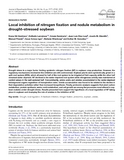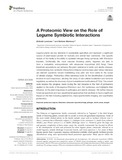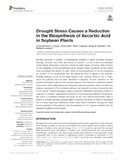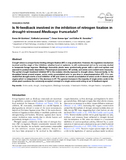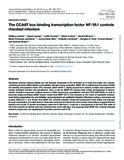Buscar
Mostrando ítems 1-10 de 10
Local inhibition of nitrogen fixation and nodule metabolism in drought-stressed soybean
(Oxford University PressSociety for Experimental Biology, 2013)
Artículo / Artikulua,
Drought stress is a major factor limiting symbiotic nitrogen fixation (NF) in soybean crop production. However, the regulatory mechanisms involved in this inhibition are still controversial. Soybean plants were symbiotically ...
Nodule carbohydrate catabolism is enhanced in the Medicago truncatula A17-Sinorhizobium medicae WSM419 symbiosis
(Frontiers Media, 2014)
Artículo / Artikulua,
The symbiotic association between Medicago truncatula and Sinorhizobium meliloti is a well-established model system in the legume–Rhizobium community. Despite its wide use, the symbiotic efficiency of this model has been ...
¿Están los bosques mixtos pirenaicos de pino silvestre y haya en el camino hacia la saturación por nitrógeno?
(Asociación Española de Ecología Terrestre, 2017)
Artículo / Artikulua,
Las actividades humanas causan altos niveles de deposición atmosférica crónica de N que pueden estar trastornando el ciclo del N en los bosques de los Pirineos occidentales. Para probar esta hipótesis, se han investigado ...
A proteomic view on the role of legume symbiotic interactions
(Frontiers Media, 2017)
info:eu-repo/semantics/article,
Legume plants are key elements in sustainable agriculture and represent a significant source of plant-based protein for humans and animal feed worldwide. One specific feature of the family is the ability to establish ...
Split‐root systems applied to the study of the legume‐rhizobial symbiosis: what have we learned?
(Wiley, 2014)
info:eu-repo/semantics/article,
Split-root system (SRS) approaches allow the differential treatment of separate and independent root systems, while sharing a common aerial part. As such, SRS is a useful tool for the discrimination of systemic (shoot ...
Drought stress causes a reduction in the biosynthesis of ascorbic acid in soybean plants
(Frontiers Media, 2017)
info:eu-repo/semantics/article,
Drought provokes a number of physiological changes in plants including oxidative damage. Ascorbic acid (AsA), also known as vitamin C, is one of the most abundant water-soluble antioxidant compound present in plant tissues. ...
Physiological responses of legume nodules to drought
(Global Science Books, 2011)
Artículo / Artikulua,
Legumes include important agricultural crops, as their high protein content is of primary importance for human food and animal feed. In addition, the ability of most of them to establish symbiotic relationships with soil ...
Is N-feedback involved in the inhibition of nitrogen fixation in drought-stressed Medicago truncatula?
(Oxford University PressSociety for Experimental Biology, 2013)
Artículo / Artikulua,
Drought stress is a major factor limiting nitrogen fixation (NF) in crop production. However, the regulatory mechanism involved and the origin of the inhibition, whether local or systemic, is still controversial and so far ...
Drought stress provokes the down-regulation of methionine and ethylene biosynthesis pathways in Medicago truncatula roots and nodules
(Wiley, 2014)
Artículo / Artikulua,
Symbiotic nitrogen fixation is one of the first physiological
processes inhibited in legume plants under water-deficit conditions.
Despite the progress made in the last decades, the
molecular mechanisms behind this ...
The CCAAT box-binding transcription factor NF-YA1 controls rhizobial infection
(Oxford University Press, 2014)
info:eu-repo/semantics/article,
Symbiosis between legume plants and soil rhizobia culminates in the formation of a novel root organ, the 'nodule', containing bacteria differentiated as facultative nitrogen-fixing organelles. MtNF-YA1 is a Medicago ...

